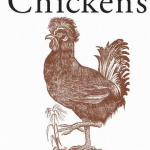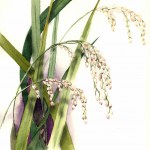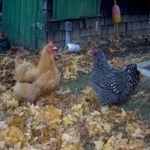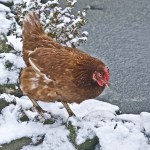Chickens
I liked Chickens: Their Natural and Unnatural Histories by Janet Lembke even if it is annoyingly unscholarly in places where it should be (assertions of fact are frequently made with zero or poor referencing). As far as I can tell, the writing is accurate in its coverage of all things Chicken. Chickens in science, chickens in stories, chickens in the back yard, chickens in history, chickens in evolution, chickens in art, chickens in mythology, chickens in medicine, chickens in Medieval times, chickens in Renaissance times, chickens all the way down.
If you are a chicken person you should…
In the NYTimes today, Nicholas Kristoff asks just the wrong question "Is an egg for breakfast worth this?" Of course, it isn't, but that's not the right way to frame this. Nothing about an egg for breakfast could be worth this in terms of animal cruelty, human health or any number of other considerations:
"It's physically hard to breathe because of the ammonia" rising from manure pits below older barns, said the investigator, who would not allow his name to be used because that would prevent him from taking another undercover job in agriculture. He said that when workers needed to enter…
The ecology of antibiotic resistance on farms is complicated. Animals receive antibiotic doses in their food and water, for reasons of growth promotion, disease prophylaxis, and treatment. Other chemicals in the environment, such as cleaning products or antimicrobial metals in the feed, may also act as drivers of antibiotic resistance. Antibiotic-resistant organisms may also be present in the environment already, from the air, soil, or manure pits within or near the barns. Ecologically, it's a mess and makes it more difficult to attribute the evolution and spread of resistance to one…
"It is soooo hard to wait, Mom!"
Isaiah is seven years old and when you are seven, uncertainty is torture. He asks me when the mail will get here 20 times a day, and can he go out and wait for the mail truck? I point out that it is 4 degrees F out there, and the mail won't be here for three hours, but he and his youngest brother still go out until the cold drives them back.
What's he waiting for? Not birthday presents or toys, he's waiting for the Murray McMurray hatchery catalog to come in the mail. Isaiah, you see, is a poultry addict, and his addiction is all my fault.
Last year we…
The last common ancestor of plants and animals may have lived 1 billion years ago. Plants and animals have occasionally exchanged genes, but for the most part, have countered selective pressures independently. Microbes (bacteria, eukaryotes, and viruses) were omnipresent threats, influencing the direction of multi-cellular evolution. Receptors that detect molecular signatures of infectious organisms mediate awareness of non-self, and are integral to host defense in plants and animals alike. The discoveries leading to identification of these receptors and their ligands followed a similar…
For the Grow your Own Bakeoff, a blogging event that celebrates the foods we grow or raise ourselves and the dishes we make using our homegrown products, I baked a Swiss chard-Gruyere pie.
Here is the recipe: First, gather as many ingredients as you can from your garden. In our garden, I found multi-colored swiss chard, Kale, chives, thyme and parsley. Our young hens, Snickerdoodle, Lemon Drop, Raven, Cheez-It and Oreo provided the eggs.
The backdrop to our garden is a mural on the side of our barn, painted with California poppies, rice plants, sunflowers and (look closely) a red…
If you are anywhere near the Massachusetts North Shore, you could come on up on Saturday between 10 and 2 to Beverly. Say howdy, hang out, talk poultry, see the fanciest and newly expanded chicken coop in town and enjoy what is supposed to be a stunningly beautiful spring day near the seashore. My Moms are holding their second annual "Chicken Open House" to encourage new poultry keepers, and we'll be visiting. Last year they expected 20 people and more than a hundred showed up - it was a blast.
The address is 10 Harrison Ave, Beverly, MA 01915.
Here's more info! Hope to see some of you…
These little guys are my Stepmom's baby chickens. Aren't they adorable?
Photo by Sue Wilcox
Happy Easter Everyone!
Chores sounds like such a dreary word, and until I moved to a farm, I would never have believed that I'd have anything positive to say about it. As a kid, I did chores around the house, and while I may have groused less about the dishes and cleaning gutters as an adult, I certainly didn't (and don't) love the jobs.
But on a farm, chores are something else - they are bookends to each day, a formal structure like the forms of a sonnet or musical scales that shape the day. They can be speeded up, slowed down, slightly elided and occasionally contracted out, but for the most part, they are…
I really should be working on the book, but just a couple more:
The amazing Louis Jordan performing "There Ain't Nobody Here But Us Chickens" - fabulous!
I admit, I have a lasting fondness going back to high school (hey, I'm a kid of the 80s, what can I say) for John Mellencamp, and he certainly has worked his ass off to raise comprehension of the farm problem in America - and he's been singing it at FarmAid concerts for decades. I have to include "Rain on the Scarecrow" which makes as much sense now as when I was a kid - maybe that's why I don't even mind his 80s hair:
There are only 4…
You'd be surprised at how warm our barn is on winter nights. A few nights ago, the thermometer read -10 as I headed out the door, and the wind was howling, but inside the barn it was below freezing, but surprisingly tolerable. Close down a comparatively small space, insulate the floors with dry bedding and fill it with warm life, and the combined body heats make it surprisingly pleasant.
Up in the rafters, some of the chickens and the turkeys are nested for the night, and they snuggle together. In the rest of the barn, they also nest in a heap. The goats snuggle together for warmth,…
One of the roles our farm has, rather unintentionally, taken on is as sanctuary (mostly temporary) for the unwanted roosters of friends and loved ones. First, there was Cora, who turned out to be Corey - and not permissable under town regulations. My step-mother relocated him here and found Eunice, a hen, and Corey lived a happy life on our farm for about a year, until he got aggressive and started attacking my children. After he jumped Asher, then two, as Asher puts (still with some satisfaction), "We ate Corey." There are far too many gentle animals in the world you can't keep to hold…
The prospect of infections spreading from animals to humans has become all too real with the onset of the current swine flu pandemic, and the threat of a bird flu still looming. But infections can jump the other way too. Decades before the world's media were gripped with panic over bird flu, humans transferred a disease to chickens and it has since caused a poultry pandemic right under our noses.
The infection in question is a familiar one - Staphylococcus aureus, a common human bacterium that's behind everything from mild skin infections to life-threatening MRSA. It causes chicken…
A notorious bacterial foe has made its first documented appearance in the U.S. and is jumping species around the farm scene. First, MSRA—methicillin resistant Staphylococcus aureus— was found in chickens. Just recently, research conducted by ScienceBlogger Tara Smith from Aetiology found that ST398, a strain found in pigs, was also found in many of the humans who came into contact with the pigs at a large food production farm in Iowa. While this strain seems to spread readily between animals and humans, its potential for lethal infections is still unclear.
Related ScienceBlogs Posts:
Swine…





